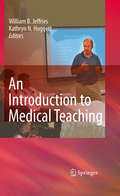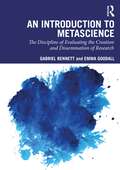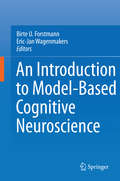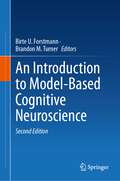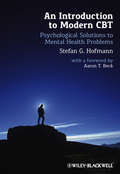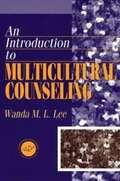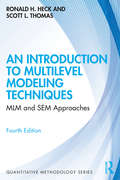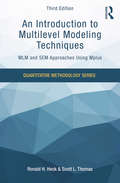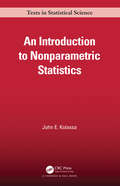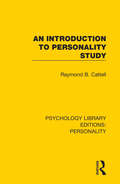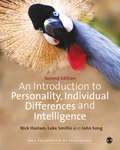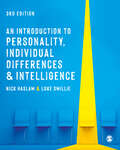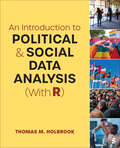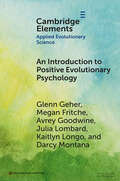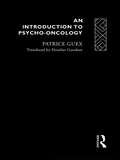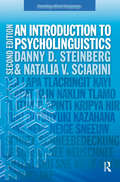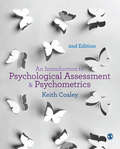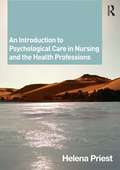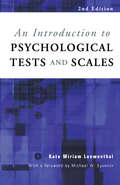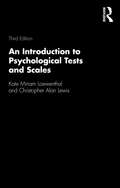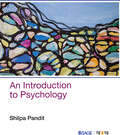- Table View
- List View
An Introduction to Medical Teaching
by William B. Jeffries Kathryn HuggettFew faculty members in academic medical centres are formally prepared for their roles as teachers. This work is an introductory text designed to provide medical teachers with the core concepts of effective teaching practice and information about innovations for curriculum design, delivery, and assessment. It offers brief, focused chapters with content that is easily assimilated by the reader. Topics are relevant to basic science and clinical teachers, and the work does not presume readers possess prerequisite knowledge of education theory or instructional design. The authors emphasize application of concepts to teaching practice. Topics include: Helping Students Learn; Teaching Large Groups; Teaching in Small Groups; Problem Based Learning; Team-Based Learning, Teaching Clinical Skills; Teaching with Simulation; Teaching with Practicals and Labs; Teaching with Technological Tools; Designing a Course; Assessing Student Performance; Documenting the Trajectory of your Teaching and Teaching as Scholarship. Chapters were written by leaders in medical education and research who draw upon extensive professional experience and the literature on best practices in education. Although designed for teachers, the work reflects a learner-centred perspective and emphasizes outcomes for student learning. The book is accessible and visually interesting, and the work contains information that is current, but not time-sensitive. The work includes recommendations for additional reading and an appendix with resources for medical education.
An Introduction to Metascience: The Discipline of Evaluating the Creation and Dissemination of Research
by Emma Goodall Gabriel BennettAn Introduction to Metascience delves into core metascientific concepts, offering a critical examination of current knowledge creation processes and scrutinising researchers and their methodologies across disciplines.This book stands alone as a comprehensive guide to metascience, offering readers a singular resource for understanding and implementing metascientific principles into their research practices. Readers will find this book invaluable for perfecting their research skills and enhancing the quality of their academic work. It exposes the reader to the intricacies of research processes, prompting a reevaluation of preconceived notions and fostering a deeper understanding of the flaws and solutions inherent in knowledge creation. Furthermore, it offers thought-provoking insights into implementing strategies to enhance research productivity, and it elucidates both the benefits and pitfalls of incorporating artificial intelligence in research production.Designed for scientists and researchers seeking to gain insight into the scientific process, An Introduction to Metascience caters to those interested in understanding how research evolves over time. It appeals to individuals eager to explore methods, practices, and philosophies of science to refine their approach to knowledge creation.
An Introduction to Model-Based Cognitive Neuroscience
by Eric-Jan Wagenmakers Birte U. ForstmannTwo recent innovations, the emergence of formal cognitive models and the addition of cognitive neuroscience data to the traditional behavioral data, have resulted in the birth of a new, interdisciplinary field of study: model-based cognitive neuroscience. Despite the increasing scientific interest in model-based cognitive neuroscience, few active researchers and even fewer students have a good knowledge of the two constituent disciplines. The main goal of this edited collection is to promote the integration of cognitive modeling and cognitive neuroscience. Experts in the field will provide tutorial-style chapters that explain particular techniques and highlight their usefulness through concrete examples and numerous case studies. The book will also include a thorough list of references pointing the reader towards additional literature and online resources.
An Introduction to Model-Based Cognitive Neuroscience
by Birte U. Forstmann Brandon M. TurnerThe main goal of this edited collection is to promote the integration of cognitive modeling and cognitive neuroscience. Experts in the field provide tutorial-style chapters that explain particular techniques and highlight their usefulness through concrete examples and numerous case studies. The book also includes a thorough list of references pointing the reader toward additional literature and online resources. The second edition of Introduction to Model-Based Cognitive Neuroscience explores important new advances in the field including joint modeling and applications in areas such as computational psychiatry, neurodegenerative diseases, and social decision-making.
An Introduction to Modern CBT
by Stefan G. HofmannAn Introduction to Modern CBT provides an easily accessible introduction to modern theoretical cognitive behavioral therapy models. The text outlines the different techniques, their success in improving specific psychiatric disorders, and important new developments in the field.* Provides an easy-to-read introduction into modern Cognitive Behavioral Therapy approaches with specific case examples and hands-on treatment techniques* Discusses the theoretical models of CBT, outlines the different techniques that have been shown to be successful in improving specific psychiatric disorders, and describes important new developments in the field* Offers useful guidance for therapists in training and is an invaluable reference tool for experienced clinicians
An Introduction to Multicultural Counseling
by Wanda M. L. LeeA history of multicultural counseling, its current issues and controversies, along with historical and sociopolitical influences in treatment methods and in testing biases.
An Introduction to Multilevel Modeling Techniques: MLM and SEM Approaches Using Mplus (Quantitative Methodology Series)
by Ronald H. Heck Scott L. ThomasMultilevel modelling is a data analysis method that is frequently used to investigate hierarchal data structures in educational, behavioural, health, and social sciences disciplines. Multilevel data analysis exploits data structures that cannot be adequately investigated using single-level analytic methods such as multiple regression, path analysis, and structural modelling. This text offers a comprehensive treatment of multilevel models for univariate and multivariate outcomes. It explores their similarities and differences and demonstrates why one model may be more appropriate than another, given the research objectives. New to this edition: An expanded focus on the nature of different types of multilevel data structures (e.g., cross-section, longitudinal, cross-classified, etc.) for addressing specific research goals Varied modelling methods for examining longitudinal data including random-effect and fixed-effect approaches Expanded coverage illustrating different model-building sequences and how to use results to identify possible model improvements An expanded set of applied examples used throughout the text Use of four different software packages (i.e., Mplus, R, SPSS, Stata), with selected examples of model-building input files included in the chapter appendices and a more complete set of files available online This is an ideal text for graduate courses on multilevel, longitudinal, latent variable modelling, multivariate statistics, or advanced quantitative techniques taught in psychology, business, education, health, and sociology. Recommended prerequisites are introductory univariate and multivariate statistics.
An Introduction to Multilevel Modeling Techniques: MLM and SEM Approaches Using Mplus, Third Edition (Quantitative Methodology Series )
by Ronald H. Heck Scott L. ThomasUnivariate and multivariate multilevel models are used to understand how to design studies and analyze data in this comprehensive text distinguished by its variety of applications from the educational, behavioral, and social sciences. Basic and advanced models are developed from the multilevel regression (MLM) and latent variable (SEM) traditions within one unified analytic framework for investigating hierarchical data. The authors provide examples using each modeling approach and also explore situations where alternative approaches may be more appropriate, given the research goals. Numerous examples and exercises allow readers to test their understanding of the techniques presented. Changes to the new edition include: -The use of Mplus 7.2 for running the analyses including the input and data files at www.routledge.com/9781848725522. -Expanded discussion of MLM and SEM model-building that outlines the steps taken in the process, the relevant Mplus syntax, and tips on how to evaluate the models. -Expanded pedagogical program now with chapter objectives, boldfaced key terms, a glossary, and more tables and graphs to help students better understand key concepts and techniques. -Numerous, varied examples developed throughout which make this book appropriate for use in education, psychology, business, sociology, and the health sciences. -Expanded coverage of missing data problems in MLM using ML estimation and multiple imputation to provide currently-accepted solutions (Ch. 10). -New chapter on three-level univariate and multilevel multivariate MLM models provides greater options for investigating more complex theoretical relationships(Ch.4). -New chapter on MLM and SEM models with categorical outcomes facilitates the specification of multilevel models with observed and latent outcomes (Ch.8). -New chapter on multilevel and longitudinal mixture models provides readers with options for identifying emergent groups in hierarchical data (Ch.9). -New chapter on the utilization of sample weights, power analysis, and missing data provides guidance on technical issues of increasing concern for research publication (Ch.10). Ideal as a text for graduate courses on multilevel, longitudinal, latent variable modeling, multivariate statistics, or advanced quantitative techniques taught in psychology, business, education, health, and sociology, this book’s practical approach also appeals to researchers. Recommended prerequisites are introductory univariate and multivariate statistics.
An Introduction to Music Therapy Theory and Practice Third Edition
by William B. Davis Kate E. Gfeller Michael H. Thaut"An Introduction to Music Therapy: Theory and Practice, third edition, provides a comprehensive overview of the practice of music therapy for the 21st century. It looks at where we have been, where we are today, and where we might be in the future. Combining sound pedagogy with recent research findings, this new edition has been updated and expanded to reflect changes in music therapy practice over the past nine years.
An Introduction to Nonparametric Statistics (Chapman & Hall/CRC Texts in Statistical Science)
by John E. KolassaAn Introduction to Nonparametric Statistics presents techniques for statistical analysis in the absence of strong assumptions about the distributions generating the data. Rank-based and resampling techniques are heavily represented, but robust techniques are considered as well. These techniques include one-sample testing and estimation, multi-sample testing and estimation, and regression. Attention is paid to the intellectual development of the field, with a thorough review of bibliographical references. Computational tools, in R and SAS, are developed and illustrated via examples. Exercises designed to reinforce examples are included. Features Rank-based techniques including sign, Kruskal-Wallis, Friedman, Mann-Whitney and Wilcoxon tests are presented Tests are inverted to produce estimates and confidence intervals Multivariate tests are explored Techniques reflecting the dependence of a response variable on explanatory variables are presented Density estimation is explored The bootstrap and jackknife are discussed This text is intended for a graduate student in applied statistics. The course is best taken after an introductory course in statistical methodology, elementary probability, and regression. Mathematical prerequisites include calculus through multivariate differentiation and integration, and, ideally, a course in matrix algebra.
An Introduction to Personality Study (Psychology Library Editions: Personality #4)
by Raymond B. CattellOriginally published in 1950, the need for a small standard text on basic principles of personality structure and development had been very apparent to teachers of psychology for some time. There were many books illustrating specialized or applied aspects of the psychology of personality – such as abnormal psychology, educational psychology, child psychology, mental measurement, vocational guidance, etc. – but lacking was a treatment of personality study as pure psychology, concentrating on the fundamentals. The aim of this title was therefore to bring the general problems of personality description and development, normal and abnormal, into a single perspective and to integrate the principle fields of observation in clear cut generalizations.
An Introduction to Personality, Individual Differences and Intelligence (SAGE Foundations of Psychology series)
by Nick Haslam Dr John Song Dr Luke SmillieThe second edition of this popular textbook builds on the strengths of the first, continuing its reputation for clarity, accessibility, conceptual sophistication and panoramic coverage of personality and intelligence. The authorship team is enriched by the addition of two high-profile international scholars, Luke Smillie and John Song, whose expertise broadens and deepens the text. New to this edition: Chapters exploring the neurobiological, genetic and evolutionary foundations of personality; and emotion, motivation and personality processes An enhanced coverage of personality disorders A thoroughly revised and extended section on intelligence which now addresses cognitive abilities and their biological bases; the role of intelligence in everyday life; and emotional intelligence A brand new companion website that includes a substantial test bank and lecture slides. An Introduction to Personality, Individual Differences and Intelligence, Second Edition is a key textbook for all psychology students on a personality or individual differences course.
An Introduction to Personality, Individual Differences and Intelligence (SAGE Foundations of Psychology series)
by Nick Haslam Dr John Song Dr Luke SmillieThe second edition of this popular textbook builds on the strengths of the first, continuing its reputation for clarity, accessibility, conceptual sophistication and panoramic coverage of personality and intelligence. The authorship team is enriched by the addition of two high-profile international scholars, Luke Smillie and John Song, whose expertise broadens and deepens the text. New to this edition: Chapters exploring the neurobiological, genetic and evolutionary foundations of personality; and emotion, motivation and personality processes An enhanced coverage of personality disorders A thoroughly revised and extended section on intelligence which now addresses cognitive abilities and their biological bases; the role of intelligence in everyday life; and emotional intelligence A brand new companion website that includes a substantial test bank and lecture slides. An Introduction to Personality, Individual Differences and Intelligence, Second Edition is a key textbook for all psychology students on a personality or individual differences course.
An Introduction to Personality, Individual Differences and Intelligence (SAGE Foundations of Psychology series)
by Nick Haslam Luke SmillieWhat does it mean to have a personality? Is emotional intelligence a kind of intelligence? Learn the answers to these questions, as well as everything you need to know about personality, intelligence, and individual differences in the third edition of this clear and accessible textbook. From natural selection to intelligence tests, and from personality disorders to the concept of IQ, the panoramic coverage of this field makes this textbook essential reading for any psychology student on a personality and individual differences course. New to this edition: · Increased coverage of intelligence · ‘Key Theorists’ feature · Discussion questions moved to end-of-chapter to enable in-text assessment Nick Haslam is Professor of Psychology at the University of Melbourne, Australia. Luke Smillie is an Associate Professor of Psychology at the University of Melbourne and director of the Personality Processes Lab.
An Introduction to Personality, Individual Differences and Intelligence (SAGE Foundations of Psychology series)
by Nick Haslam Luke SmillieWhat does it mean to have a personality? Is emotional intelligence a kind of intelligence? Learn the answers to these questions, as well as everything you need to know about personality, intelligence, and individual differences in the third edition of this clear and accessible textbook. From natural selection to intelligence tests, and from personality disorders to the concept of IQ, the panoramic coverage of this field makes this textbook essential reading for any psychology student on a personality and individual differences course. New to this edition: · Increased coverage of intelligence · ‘Key Theorists’ feature · Discussion questions moved to end-of-chapter to enable in-text assessment Nick Haslam is Professor of Psychology at the University of Melbourne, Australia. Luke Smillie is an Associate Professor of Psychology at the University of Melbourne and director of the Personality Processes Lab.
An Introduction to Political and Social Data Analysis (With R)
by Thomas M. HolbrookAn Introduction to Political and Social Data Analysis (With R) provides students with an accessible overview of practical data analysis while also providing a gentle introduction to R. By starting with statistics first and using just enough R code to generate results, this text helps students focus on learning how to do data analysis while slowly gaining confidence in using R as they progress through the material. This book is structured around learning by doing. Students can follow along in each chapter by reading about statistics and their applications in R, and then running the R code on their own as they work through contemporary political science and social science examples. Author Thomas M. Holbrook patiently explains each step in in the process, avoiding overly complicated jargon and commands. Exercises at the end of chapters feature both conceptual and calculation-based questions so students can check their understanding of data analysis and practice using R. At the end of the semester, students can confidently add skills in data analysis with R to their resumes.
An Introduction to Political and Social Data Analysis (With R)
by Thomas M. HolbrookAn Introduction to Political and Social Data Analysis (With R) provides students with an accessible overview of practical data analysis while also providing a gentle introduction to R. By starting with statistics first and using just enough R code to generate results, this text helps students focus on learning how to do data analysis while slowly gaining confidence in using R as they progress through the material. This book is structured around learning by doing. Students can follow along in each chapter by reading about statistics and their applications in R, and then running the R code on their own as they work through contemporary political science and social science examples. Author Thomas M. Holbrook patiently explains each step in in the process, avoiding overly complicated jargon and commands. Exercises at the end of chapters feature both conceptual and calculation-based questions so students can check their understanding of data analysis and practice using R. At the end of the semester, students can confidently add skills in data analysis with R to their resumes.
An Introduction to Positive Evolutionary Psychology (Elements in Applied Evolutionary Science)
by Glenn Geher Megan Fritche Avrey Goodwine Julia Lombard Kaitlyn Longo Darcy MontanaOver the past few decades, evolutionary psychology has shed light on such features of the human experience as mating, love, religion, aggression, warfare, physical health, mental health, and more. The field of positive psychology has progressed along a parallel trajectory, using behavioral science techniques to help our understanding of human thriving at the individual and community levels. Positive Evolutionary Psychology is dedicated to the integration of positive and evolutionary psychology, with an eye toward using Darwinian-inspired concepts to help advance our understanding of human thriving. This Element describes the basic ideas of this new approach to behavioral science as well as examples that dip into various aspects of the human experience, including such topics as health, education, friendships, love, and more–all with an eye toward providing a roadmap for the application of Darwinian principles to better understanding human thriving and the good life.
An Introduction to Psycho-Oncology
by Patrice GuexCancer is extremely common and in many situations a truly frightening disease, but for too long the psychological aspects and effects have been ignored. An Introduction to Psycho-Oncology deals in a clear and simple manner with the reactions of cancer patients to their illness, and the ways in which they can be helped. In the context of a multidisciplinary approach that takes account of medical treatments as well as psychological interventions, Guex offers suggestions for better ways of communicating so as to provide a therapeutic partnership between carer and client.
An Introduction to Psycholinguistics (Learning about Language)
by Danny D. Steinberg Natalia V. SciariniLearning About Language is an exciting and ambitious series of introductions to fundamental topics in language, linguistics and related areas. The books are designed for students of linguistics and those who are studying language as part of a wider course. Cognitive Linguistics explores the idea that language reflects our experience of the world. It shows that our ability to use language is closely related to other cognitive abilities such as categorization, perception, memory and attention allocation. Concepts and mental images expressed and evoked by linguistic means are linked by conceptual metaphors and metonymies and merged into more comprehensive cognitive and cultural models, frames or scenarios. It is only against this background that human communication makes sense. After 25 years of intensive research, cognitive-linguistic thinking now holds a firm place both in the wider linguistic and the cognitive-science communities.An Introduction to Cognitive Linguistics carefully explains the central concepts of categorizaÂtion, of prototype and gestalt perception, of basic level and conceptual hierarchies, of figure and ground, and of metaphor and metonymy, for which an innovative description is provided. It also brings together issues such as iconicity, lexical change, grammaticalization and language teaching that have profited considerably from being put on a cognitive basis.The second edition of this popular introduction provides a comprehensive and accessible up-to-date overview of Cognitive Linguistics: Clarifies the basic notions supported by new evidence and examples for their application in language learning Discusses major recent developments in the field: the increasing attention paid to metonymies, Construction Grammar, Conceptual Blending and its role in online-processing. Explores links with neighbouring fields like Relevance Theory Uses many diagrams and illustrations to make the theoretical argument more tangible Includes extended exercises Provides substantial updated suggestions for further reading.
An Introduction to Psychological Assessment and Psychometrics
by Keith CoaleyIn An Introduction to Psychological Assessment and Psychometrics, Keith Coaley outlines the key ingredients of psychological assessment, providing case studies to illustrate their application, making it an ideal textbook for courses on psychometrics or psychological assessment.<P><P> New to the Second Edition:<P> * Includes occupational and educational settings<P> * Covers ethical and professional issues with a strong practical focus<P> * Case study material related to work selection settings <P> * End of chapter self-assessments to facilitate students’ progress<P> * Complaint with the latest BPS Certificate of Testing curriculum
An Introduction to Psychological Care in Nursing and the Health Professions
by Helena PriestCaring is at the core of what nurses and other health professionals do. But caring encompasses more than simply looking after people’s physical health needs. People requiring any health service will have psychological needs that affect their feelings, thoughts, and behaviour. Good psychological care can even help improve physical health outcomes. An Introduction to Psychological Care in Nursing and the Health Professions explains and promotes the importance of psychological care for people when they become physically ill, giving a sound theoretical basis to ensure care is evidence-based. It encourages the reader to think about the effects of illness and disability on patients, and to understand what can be done to identify and minimise any difficulties they might be experiencing in these areas. The chapters cover: the meaning and elements of care and holistic care; a model of psychological care in practice; the personal qualities and skills of carers that best underpin psychological care delivery, and how these might be enhanced; the knowledge needed for effective psychological caregiving; psychological care as it might be practised in a range of health care settings. This text contains key learning points, practical activities, reflective exercises and case illustrations. It is ideal for student and practising nurses, and health professionals who would like to improve their care for patients in this essential area.
An Introduction to Psychological Tests and Scales
by Kate Loewenthal Christopher Alan LewisIn its first edition this book successfully enabled readers, with little or no prior knowledge of computing or statistics, to develop reliable and valid tests and scales for assessment or research purposes. In this edition, the author has thoroughly updated the text to include new recent advances in computer software and provide information on relevant internet resources. The book contains detailed guidelines for locating and constructing psychological measures, including descriptions of popular psychological measures and step-by-step instructions for composing a measure, entering data and computing reliability and validity of test results. Advanced techniques such as factor analysis, analysis of covariance and multiple regression analysis are presented for the beginner.An Introduction to Psychological Tests and Scales provides a clear, concise and jargon-free primer for all those embarking in fieldwork or research analysis. It will be an invaluable tool for undergraduates and postgraduates in psychology and a useful text for students and professionals in related disciplines.
An Introduction to Psychological Tests and Scales
by Christopher Alan Lewis Kate Miriam LoewenthalThis text is a vital resource for those with little or no prior knowledge of computing or statistics to aid in the development of reliable and valid tests and scales for assessment or research purposes. It serves as a clear, concise and jargon-free primer for all those embarking in fieldwork or research analysis. The book contains detailed guidelines for locating and constructing psychological measures, including descriptions of popular psychological measures and step-by-step instructions for composing a measure, entering data, and computing reliability and validity of test results. Advanced techniques such as factor analysis, analysis of covariance, and multiple regression analysis are presented for the beginner. This new edition has been revised throughout and includes updated statistical test procedures in line with the new version of SPSS and the inclusion of current academic articles. It serves as an invaluable resource for undergraduates and postgraduates across the behavioral and social sciences, as well as professionals in related disciplines, including those working in management and medical sciences.
An Introduction to Psychology
by Shilpa PanditA comprehensive, inter-disciplinary foundational book on psychology with socio-cultural contexts and practical applications This textbook is specifically designed to provide foundational knowledge to students of psychology. It explains the basic principles of psychology in a clear and accessible manner. It uses examples drawn from real life to provide a context for the theories of psychology. The book is unique in the way it introduces the study of psychology in the context of Indian issues and culture. It integrates indigenous perspectives on topics such as yoga, cognition and health with conventional theories of psychology without compromising on scientific rigour. Each chapter is designed to engage the learners by presenting practical applications of theories as well as relevant stories from Indian and international media. These features along with recent research studies and possible future research questions in the field make Introduction to Psychology an indispensable manual for Indian students of psychology. Key Features: • Examples from the Indian context to make the content more relatable to students • Inter-disciplinary approach which relates psychology to allied subjects like sociology and cognitive sciences • Updated with information about current trends in research in the subject • Follows the curriculum of major Indian universities
